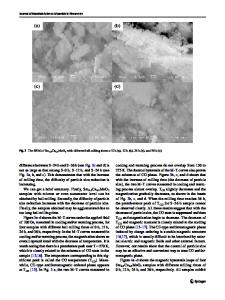Effects of the sintering temperature on the La 0.63 Gd 0.37 MnO 3 structure and magnetic properties
- PDF / 2,662,591 Bytes
- 14 Pages / 595.276 x 790.866 pts Page_size
- 33 Downloads / 298 Views
Effects of the sintering temperature on the La0.63Gd0.37MnO3 structure and magnetic properties Anas Rasras1 · Riheb Hamdi2,3 · Said Mansour4 · Ayman Samara4 · Yousef Haik5 Received: 22 April 2020 / Accepted: 26 September 2020 © Springer-Verlag GmbH Germany, part of Springer Nature 2020
Abstract La0.63Gd0.37MnO3 material was synthesized using the Pechini-modified-sol–gel method at different sintering temperatures 600, 650, 750, 800, and 900 °C. After characterizing the samples structurally and magnetically, we report a direct relation between the crystallite size, particles agglomeration level, and material performance in field-cooling/zero-field-cooling magnetization modes, in addition to an inverse relation between the existence of Griffith phase and the samples’ magnetocaloric performance. The material sintered at 800 °C presents the maximum isothermal entropy change among others that is 7.57 J kg−1 K−1 at 7 T, in addition to a good performance shown at higher temperatures, making it a promising candidate for different cooling applications. Keywords LaGdMnO3 · Perovskite manganites · Magnetocaloric refrigeration · Cryogenic cooling
1 Introduction Solid-state cooling, specifically magnetic refrigeration has attracted researchers’ interests for being a promising candidate to disrupt the cooling industry due to its environmentally-friendly nature, high theoretical efficiency, and longterm reliability [1–4]. Refrigeration systems, in general, rely on the material’s entropy change ∆S due to a change in external parameters such as pressure (elastocaloric effect ECE) or magnetization (magneto-caloric effect MCE) to absorb or reject thermal energy [5]. Magnetic refrigeration is a technology that utilizes materials MCE in correspondence to the ECE utilized in compression-based refrigeration [6]. MCE in materials is manifested as an adiabatic increase * Yousef Haik [email protected] 1
College of Science and Engineering, Hamad Bin Khalifa University, Qatar Foundation, Doha, Qatar
2
College of Health and Life Sciences, Hamad Bin Khalifa University, Qatar Foundation, Doha, Qatar
3
Laboratoire de Physique Appliquée, Faculté Des Sciences, Université de Sfax, B.P. 1171, 3000 Sfax, Tunisia
4
Core Labs, Qatar Environment and Energy Research Institute, Ar‑Rayyan, Qatar
5
Department of Mechanical and Industrial Engineering, Texas A&M University-Kingsville, Kingsville, TX 78363, USA
in temperature as a reaction to a change in external magnetic field application [7, 8]. Many recent studies have focused in the MCE in perovskite manganites, because of different important benefits [9–11]. Specifically, perovskite manganites have gained interests because of their colossal magnetoresistance effect [12], magnetoelectric switching [13, 14], magnetoelectric coupling, and the diverse phase diagrams that they have [15, 16]. These properties have enabled scientists in different fields to study manganites disorders, Jahn–Teller distortion, magnetic-electric coupling, spin–lattice coupling, ferroelectricity coupling and
Data Loading...











